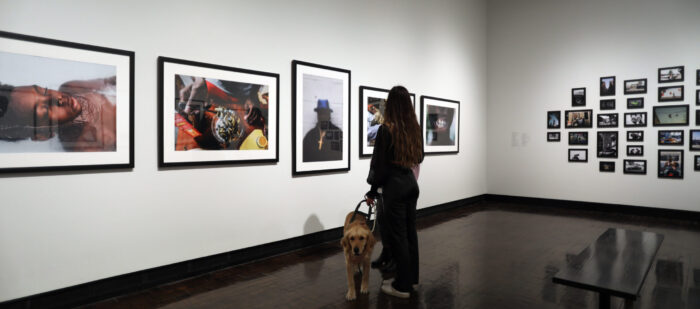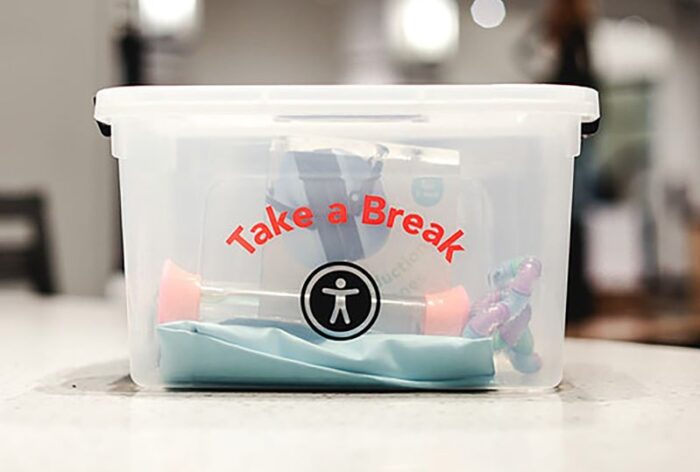The Frist Art Museum gratefully acknowledges the guidance and assistance of the Tennessee Disability Coalition and Empower Tennessee (formerly, the Center for Independent Living). Since prior to the opening of the Frist Art Museum in 2001, the staffs of these organizations have supported and inspired our efforts.
We also acknowledge the ADA National Network for their valuable resources and invaluable wisdom.
The Frist Art Museum is the 2019 recipient of Empower Tennessee’s first Access Music City Business Champion Award.
See what Nashville Moms Blog published about accessibility for families at the Frist.
Read article about accessibility at the Frist Art Museum

Accessible Parking Spaces
The Frist Art Museum Visitor Parking Lot is located on land adjacent to the building. The lot contains 90 parking spaces. The barrier-free distance from the accessible parking spaces (located in the northeast corner of the Visitor Parking Lot) to the entryway in the Turner Courtyard is approximately 125 yards.
• The Frist Art Museum has five designated accessible parking spaces (including two that are van accessible) available in the Frist Art Museum Visitor Parking Lot for vehicles displaying the appropriate hang tags and license plates. The spaces are located in the northeast corner of the Frist Art Museum Visitor Parking Lot nearest the barrier-free crossing and entrance to the Frist Art Museum and are clearly marked. There are also five additional designated accessible parking spaces (including two that are van accessible) available during select large events. They are located in the Frist’s second parking lot (the lot usually used by employees). When the second lot is opened to the public for large events, those additional designated accessible parking spaces will be available for use by visitors.
• A limited number of accessible public parking spaces are also available on 9th Avenue. Barrier-free entrances are located on 9th Avenue near Broadway and at the rear courtyard (These spaces are designated by Metro Traffic and Parking, not specifically for the Frist Art Museum.) near the service court entrance on the Demonbreun Street side of the building.
• Barrier-free building access is available from both the Frist Art Museum Visitor Parking Lot and at the corner of 9th Avenue and Broadway.
Barrier-Free Entry into the Frist Art Museum
• Enter the Frist via the entrance to the Turner Courtyard on the southeast side of the building nearest the Federal Courthouse. The barrier-free entry to the Turner Courtyard is located near the Frist Art Museum’s large generator which is clearly visible from the accessible parking spaces in the Frist Art Museum Visitor Parking Lot. The barrier-free distance from these accessible parking spaces to the building entrance is approximately 125 yards.
• There is an additional barrier-free entrance with a ramp on the corner of 9th Avenue and Broadway. The distance from the entrance to the Visitor Services Desk through the Grand Lobby is approximately 80 yards.
Service Animals are welcome at the Frist Art Museum.

For visitors with mobility needs
Please note: The Frist Art Museum occupies an entire city block. Walking from one side of the building to the other is a distance of approximately 80 yards. Because exhibitions change frequently and their contents vary widely, seating areas are not always located uniformly from one exhibition to the next.
• Wheelchairs are available free of charge on a first-come, first-served basis. Speak with a Member Desk or Guest Services staff member for assistance when you arrive. Borrowers will be asked to leave a driver’s license during the period the wheelchair is being used. Both 18-inch and 24-inch wheelchairs are available.
• There are two four-footed adjustable canes and a rolling walker available for check out through the member desk.
For visitors who are deaf or hard of hearing
• Sign Language—With advance notice, we will make every effort to arrange for American Sign Language interpreters at no additional charge. Please contact Ellen Pryor at epryor@FristArtMuseum.org or 615.744.4914 during business hours. Because ASL interpreters maintain busy schedules, please call at least three business days in advance (not including weekends) to allow sufficient time to make arrangements.
• Assistive listening devices are available for visitors with hearing loss who are attending programs in the Frist Art Museum Auditorium. Contact the staff member managing event to obtain headset that provide amplification of sound via an infrared transmission signal.

TOURS: On the first Saturday of each month, certified American Sign Language interpreters will be available for both the 1:30 p.m. Docent Walk-up Tour and the 3:30 p.m. Architecture Tour. Our Docent Walk-up Tours focus on one of the current exhibitions and require gallery admission. Our Architecture Tours explore the Frist Art Museum’s landmark Art Deco building and are free. No advance reservation for either tour is required. ASL interpretation is generously supported by Bridges for the Deaf and Hard of Hearing, a Middle Tennessee nonprofit serving the Deaf and hard of hearing community.

Supported in part by

For visitors who are blind or have low vision
• Gallery Guides at 30% larger than the regular size are available for most exhibitions and are available to check out at Guest Services.
• Large magnifiers to facilitate looking at artwork details may be borrowed from the Guest Services and Member desks and from the Information Desk just inside the galleries.
• Braille signage on rooms throughout the building.
• A Brailled guide for the From Post Office to Art Museum brochure is also available at the Guest Services Desk, at the Membership Desk, and at the Volunteer Information Desk at the entrance to the Ingram Gallery.
• Audio Tours are available for select exhibitions and can be accessed from your smart phone by scanning a QR code at the gallery entrance.
• Docent-guided exhibition tours are available daily at 1:30 p.m.
“Take a Break” Sensory Kits
In an effort to make the Frist a more comfortable and welcoming experience for all of our guests, we are pleased to offer our Take A Break sensory kits. These kits are geared toward those with sensory challenges but are available to anyone who needs a little help calming and focusing while visiting the museum. You are welcome to take the kit anywhere inside the museum—the foyers on the upper level are a great option for a quiet spot.

Each kit includes a weighted lap pad, noise-cancelling headphones, disposable headphone covers, a timer, tangle and sensory tube fidgets, and sanitizing wipes. The kits are available to check out in Martin ArtQuest on the upper level.
Social Story
Social Stories are social learning tools that support the safe and meaningful exchange of information between parents, professionals, and people with autism of all ages. A Social Story has been created for the Frist Art Museum that can be printed out or viewed directly from the website on a computer or mobile device to help visitors with autism know what to expect when coming to the museum.
Additional information on social stories can be found here.
Multisensory Tours
For select exhibitions, through verbal description, scent experience, and tactile exploration, visitors will be able to experience art in an exciting new way. To inquire about a multisensory tour contact learning@FristArtMuseum.org.
Accessible Rest Rooms
Accessible Rest Rooms are located throughout the Frist Art Museum:
• In the Conte Community Arts Gallery
• Inside the Auditorium doors near the water fountains (these are large restrooms appropriate for family use.)
• Inside the galleries on the upper level at the top of each stairway
• In the education hallway on the upper level.
Café Cheeserie
The Café Cheeserie has tables to accommodate wheelchairs.
For visitors who speak a language other than English
The Frist is able to provide a language interpreter if needed (a two week advance notice is required).
The Frist Art Museum website
FristArtMuseum.org conforms to W3C Best Practices and those Web Accessibility Guidelines that apply to our site. The website is audited quarterly to periodically assess accessibility. In summary:
• Images on the site includes “alt” text which explains the content of the image. There is also contextual information included around each image to explain why it is included where it is.
• Information conveyed by color (such as sidebar navigation) is also structured by the markup in a way consistent to conveying the same information.
• Foreground, background, and text color combinations provide sufficient contrast to be viewed by people with color deficits.
• Style sheets are used to control layout and presentation, removing them from the content of the page itself and thus allowing screen readers to function correctly without including this additional, unnecessary, and non-contextual information.
• Relative units of position are used throughout the HTML/CSS markup, meaning the structure of the HTML is consistent with its visual layout, allowing screen readers to properly read elements on the screen in the correct order.
• Header HTML elements are used to convey document structure and importance, allowing screen readers to correctly determine the actual content of the page.
• Lists and list items are marked up properly.
• HTML markup is used in accordance with their intended use and W3C best practices. No HTML elements are used improperly, and no special characters are used to affect the visual layout of a page.
• Documents are organized so that they may be read without style sheets.
• There are no pop-ups or other windows that appear, and the current window’s content does not change without informing the user.
• Audio/Visual content such as videos have text descriptions associated with them to provide context and information about the content of the video.
• Exhibition entries are accompanied by in-depth, text-based articles and headlines and sub-headlines are descriptive and refer to the entry in closest proximity.
